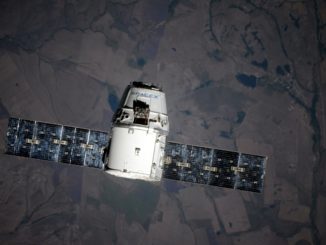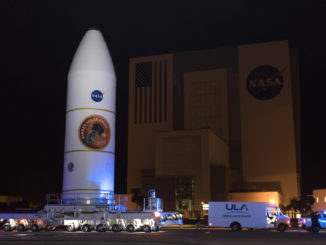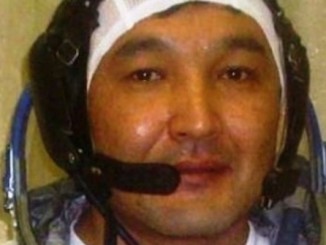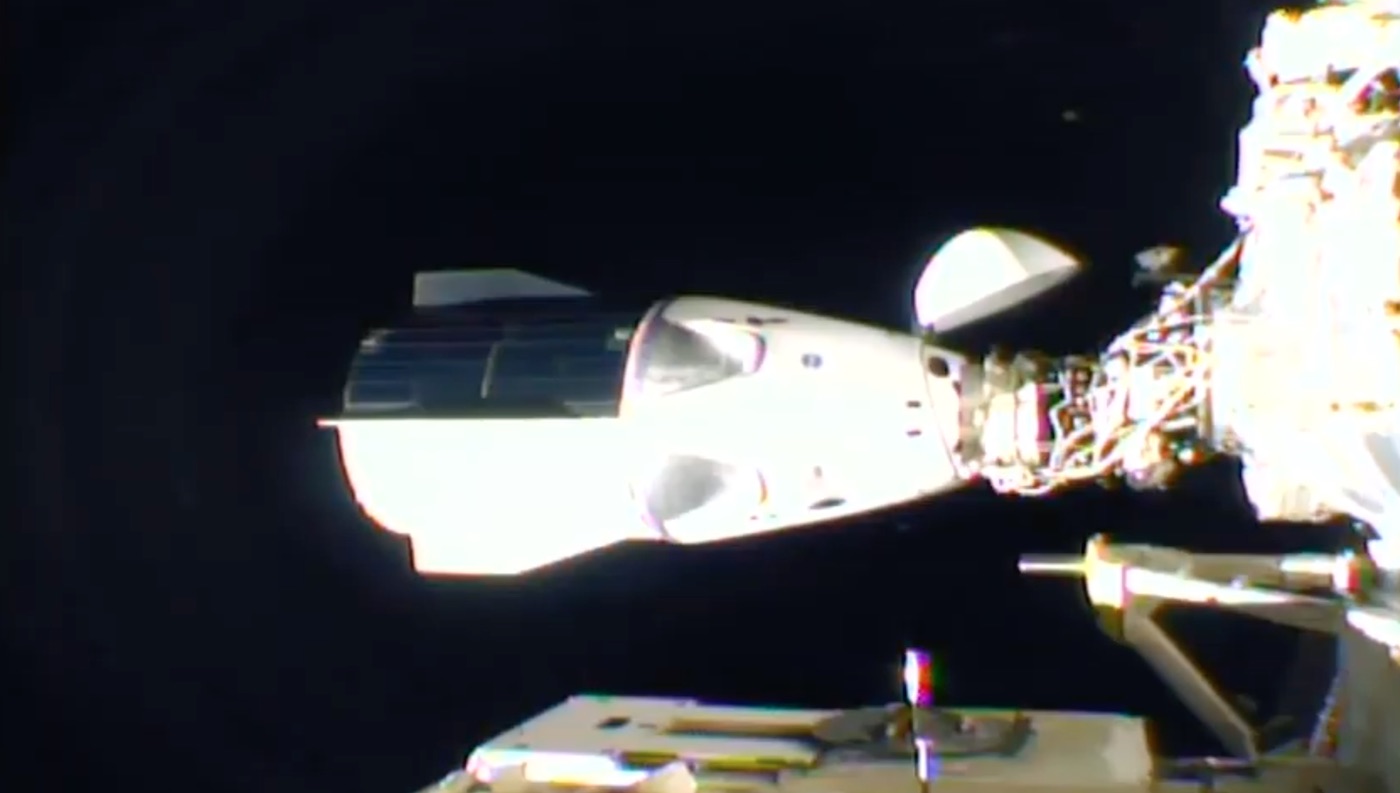
SpaceX’s Crew Dragon Resilience spacecraft glided to a smooth automated docking Monday night at the International Space Station, delivering four astronauts to join the three-person crew already on-board, boosting the size of the lab’s long-duration crew to seven for the first time.
The space station has typically been staffed with six long-duration crew members since 2009, expanding from two- and three-person crews during construction of the research outpost. A seven crew member increase the scientific output of the more than $100 billion research complex.
“We look forward to a significant amount of time on orbit, a significant number of months we’ll be able to increase the amount of science, the amount of research, the amount of technology development we can do with the additional crew members,” said Joel Montalbano, NASA’s space station program manager.
NASA astronauts Mike Hopkins, Victor Glover, Shannon Walker, and Japanese astronaut Soichi Noguchi monitored the Crew Dragon’s automated final approach to the space station Monday night. The commercial crew capsule — named “Resilience” by the astronauts — docked with the station’s Harmony module on autopilot at 11:01 p.m. EST Monday (0401 GMT Tuesday), capping a 27-and-a-half hour flight to the space station after launch Sunday night from NASA’s Kennedy Space Center in Florida.
“SpaceX, this is Resilience, excellent job right down the center,” Hopkins radioed SpaceX mission control in Hawthorne, California. “SpaceX and NASA, congratulations. This is a new era of operational flights to the International Space Station from the Florida coast.”
The Crew Dragon flight — designated Crew-1 — is the first of at least six operational crew rotation missions to the space station contracted to SpaceX by NASA. In a two-day review last week before the launch of the Crew Dragon, the space agency formally certified the capsule, its Falcon 9 rocket, and ground systems for regular crew flights to the space station, punctuating a multibillion-dollar development and test program that lasted more than a decade.
NASA commander Mike Hopkins and crewmates Victor Glover, Soichi Noguchi, and Shannon Walker have floated into the International Space Station.
They join Sergey Ryzhikov, Sergey Kud-Sverchkov, and Kate Rubins to give the space station a crew of seven.https://t.co/baLJVLCH0T pic.twitter.com/Il5Bj809DO
— Spaceflight Now (@SpaceflightNow) November 17, 2020
A few hours later, Hopkins and his crewmates opened the Crew Dragon’s forward hatch and floated into the space station’s Harmony module. Space station flight engineer Kate Rubins, Russian commander Sergey Ryzhikov, and cosmonaut Sergey Kud-Sverchkov greeted the Dragon crew.
The seven astronauts and cosmonauts make up the space station’s Expedition 64 crew, and they will live and work on the research outpost until April, when they will prepare to return to Earth after a fresh crew arrives.
Seven-person crews will be the norm through the rest of the space station’s lifetime. The life support system on the research lab has been capable of accommodating seven crew members for years, but the station’s crew size was limited by the number of seats available on Russian Soyuz spacecraft.
From the retirement of the space shuttle in 2011 until this year, the Soyuz was the only vehicle capable of ferrying crews to and from the space station. Each Soyuz has three seats, and the Russian segment of the space station typically had two Soyuz capsules docked at a time.
With SpaceX’s Crew Dragon spacecraft now providing crew transportation services — and Boeing’s Starliner expected to be ready for astronaut flights next year — Russia’s space agency has cut the number of Soyuz crew launches from four to two per year.
NASA paid Russia for Soyuz seats while there was no U.S. spacecraft available to launch and land with astronauts. With the Crew Dragon’s development complete, and the Starliner nearing readiness for crew missions, NASA is ending its purchases of Soyuz seats.
NASA is working on an intergovernmental agreement with Russia to continue flying U.S. and international astronauts on Soyuz flights in exchange for arranging seats for Russian cosmonauts on Crew Dragon and Starliner missions to the space station.
The Starliner and Crew Dragon spaceships are designed to launch and land with four astronauts. Combined with a three-person Soyuz crew, that allows the space station’s crew complement to go from six to seven.
A big benefit of the added crew member will be to increase the space station’s capacity for scientific research.
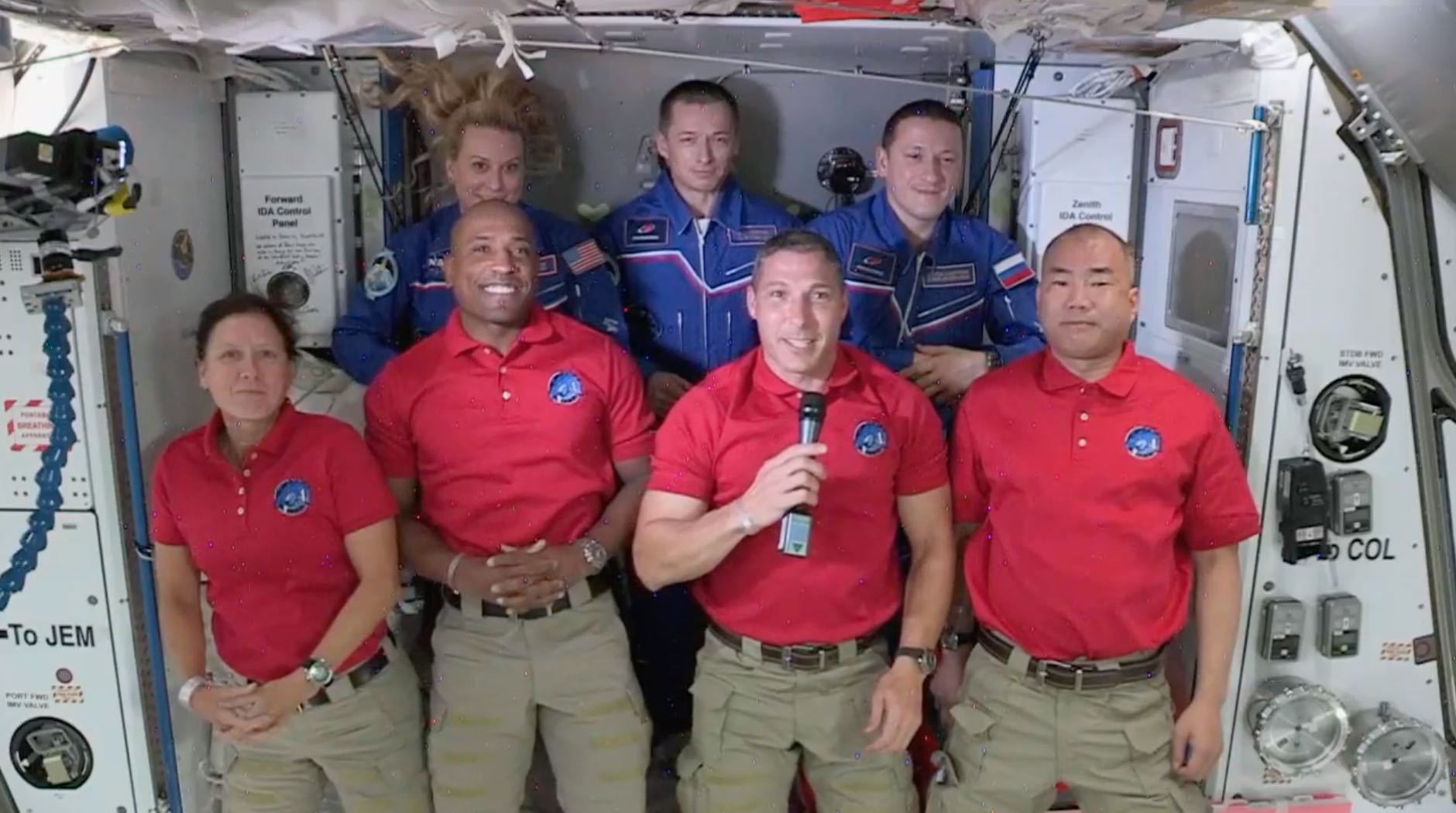
The space station’s U.S. segment, which includes contributions from Europe, Japan, and Canada, now has five crew members with the arrival of the Crew Dragon Resilience mission. There are currently two Russian cosmonauts on the station, but Russia plans to have three cosmonauts flying on the complex again next year, bringing the long-term mix of crew members to three in the Russian segment and four in the U.S. segment, including astronauts from the other international partners.
“One of the cool things about having the Commercial Crew Program is we’re able to double the amount of crew-tended science and research and technology development we do on-board the International Space Station,” Montalbano said. “With three (U.S. segment) crew members, we were averaging about 35 hours a week of crew-tended science research. With a fourth crew member, that person’s time — the equivalent time — is dedicated to science and utilization and research.
“So we’ll be able to do 70 hours with the 4 crew members,” Montalbano said. “That kind of sets the standard for us as … we continue to develop the International Space Station, continue to use, and allows us to do not only the science and research we have, but technology demonstration that will help us with the Artemis program.”
The Artemis program is NASA’s program to return astronauts to the moon’s surface, build a small space station in lunar orbit, and establish a continuous human presence at the moon.
“The amount of research that we can get done, and the things that we can get done with just one or two more people is more than just one or two more people’s worth of science,” Walker said.
With five astronauts living and working in the U.S. section of the space station, there might be challenges in scheduling the crew’s daily activities. For example, teams will have to ensure all the astronauts have time each day to use the station’s exercise equipment, Walker said.
“There’s the comm (communications), the video loops, all of those feeds,” Hopkins said in a pre-flight press conference. “When we’re doing experiments and things like that, a lot of the investigators want to be able to see what we’re doing real-time, and now all of a sudden potentially you could have five different people working on five different experiments on the International Space Station. So do we have the resources that enable that? I think that is certainly going to bring some challenges with it.”
The U.S. segment also has four bunks, and a new sleeping station may not arrive at the outpost until after the Crew-1 astronauts depart next year. Hopkins plans to sleep inside the Crew Dragon Resilience spacecraft.
“I think there’s a tradition that oftentimes in the shuttle days, the commander usually slept in the cockpit,” Hopkins said. “So, at least for me, it just felt right that was where I needed to be. If any of us were going to sleep there, I felt like it should have been me.”
The astronauts have a busy schedule ahead of them, with numerous scientific experiments, arrivals and departures of U.S. and Russian cargo freighters, and maintenance tasks.
Hopkins, Glover, Noguchi, and Rubins plan to perform a series of spacewalks early next year to ready a European science platform for service outside the space station’s Columbus module. The spacewalk tasks also include an upgrade to a communications system associated with the European Columbus module, and some work on Japan’s robotic arm.
Other items on the spacewalking checklist next year include preparations for new solar arrays to be installed outside the space station, according to Kenny Todd, NASA’s deputy space station program manager.
Ryzhikov and Kud-Sverchkov are also gearing up for a spacewalk outside the Russian segment of the space station Wednesday.
While Hopkins and his crewmates are full-fledged members of the space station’s Expedition 64 crew, their mission also includes some checkout objectives on the Crew Dragon spacecraft.
The Crew-1 mission is the first time four astronauts have flown on a Crew Dragon spacecraft — and the first time a four-person crew have been inside any capsule in orbit. Past space missions flying on crew capsules have carried no more than three astronauts, while NASA’s space shuttle accommodated as many as eight astronauts.
Hopkins and his crewmates will fly nearly three times longer than astronauts Doug Hurley and Bob Behnken did on their Crew Dragon test flight earlier this year, pushing the capsule close to its 210-day maximum mission duration.
“Bob and Doug’s mission was the developmental test mission,” Glover said in a pre-flight press conference, referring to Crew Dragon’s Demo-2 mission. “As soon as we hit Day 64, that’s going to be the first time that a Crew Dragon at the space station his hit that milestone, and every day after that will be new territory.”
“In general, I think it’s more of an operational checkout than development testing,” Hopkins said.
The start of SpaceX’s operational crew rotation flights signals a new era in commercial spaceflight. NASA and private sector officials hope it will ultimately lead to more access to low Earth orbit for regular people, commercial space stations and habitats, and a growing space economy.
Paying passengers will initially have to be wealthy or well-funded, with a Crew Dragon seat priced at around $55 million.
“The big milestone here is we are now moving from development and test and into operational flights,” said NASA Administrator Jim Bridenstine.
NASA has spent $6 billion over the last decade helping companies develop new commercial human-rated spacecraft. In 2014, the space agency selected SpaceX and Boeing as partners to complete development of the Crew Dragon and Starliner crew capsules.
SpaceX has signed agreements with NASA valued at more than $3.1 billion to cover design, testing, and six operational flights of the Crew Dragon spacecraft.
Hopkins, 51, is a native of Missouri and a colonel in the U.S. Air Force. He served as a flight test engineer before his selection as a NASA astronaut in 2009, then completed a 166-day expedition on the space station in 2013 and 2014. NASA named him to command the first operational Crew Dragon mission in 2018.
Glover is the mission’s rookie, and he is set to become the first Black astronaut to live and work on the space station for a long-duration expedition. The 44-year-old U.S. Navy test pilot was born and raised in Southern California, graduated with a bachelor’s degree in engineering from Cal Poly, then flew F/A-18 fighter jets before joining NASA’s astronaut corps in 2013.
Shannon Walker was born in Houston and earned a bachelor’s degree, master’s degree, and a PhD in space physics from Rice University. Walker, 55, was a flight controller and integration engineer on the space shuttle and space station before NASA selected her as an astronaut in 2004. She logged 163 days in orbit on the space station in 2010.
Noguchi, 55, is the most experienced astronaut on the Dragon crew. With Sunday night’s launch, Noguchi became the third person to blast off from Earth and fly into orbit on three different types of spacecraft, joining a small club with legendary NASA astronauts Wally Schirra and John Young.
He previously flew on a space shuttle mission and launched on a Russian Soyuz rocket to the space station. The Crew-1 mission is Noguchi’s third spaceflight.
The next Crew Dragon mission is tentatively scheduled to launch March 30 with an all-veteran crew led by NASA commander Shane Kimbrough, pilot Megan McArthur, Japanese astronaut Akihiko Hoshide, and European Space Agency astronaut Thomas Pesquet. They will ride the same Crew Dragon Endeavour capsule that Hurley and Behnken flew earlier this year.
A fresh three-man team of Russian cosmonauts will launch around April 10 to replace Rubins, Ryzhikov, and Kud-Sverchkov, who are slated to land in their Soyuz capsule in mid-April. Then Hopkins and his crewmates will leave the complex and head splashdown in the Atlantic Ocean or Gulf of Mexico some time around May 1.
Email the author.
Follow Stephen Clark on Twitter: @StephenClark1.

